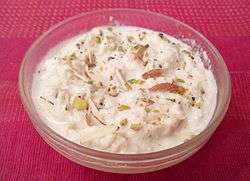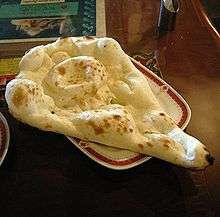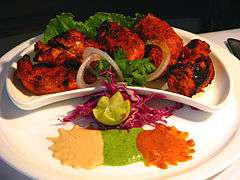Rabri
 | |
| Alternative names | Rabdi |
|---|---|
| Associated national cuisine | Indian, Pakistani |
| Main ingredients | Milk and pearl millet flour |
|
| |
Rabri (IAST: Rābaḍī; Hindi: राबड़ी, Rajasthani: राबड़ी, Odia: ରାବିଡି) is a sweet, condensed milk based dish made by boiling the milk on low heat for a long time until it becomes dense and changes its color to pinkish. Sugar, spices and nuts are added to it to give it flavor. It is chilled and served as dessert. Rabri is the main ingredient in several desserts, such as rasabali, chhena kheeri, and khira sagara.
Variants
Rabri is an Indian and Pakistani sweet dish made with dahi (yogurt), flour, and a combination of bajre ki roti. It is usually eaten at lunch. Raabri is mostly made in north, central and western India. Flour of pearl millet (bajri) is mixed with buttermilk to make a thick sauce which is kept in the sun to ferment. After about 3 to 4 hours, it is cooked by boiling it until the flour is cooked. It may be eaten hot as soup, but it is usually kept overnight. It may be mixed with yogurt or buttermilk. Cumin seeds (zeera), dry fruits, etc., can be used as garnish. Rabri can also be made savoury with salt, masala, and zeera.
Calcutta Rabri
The quintessential rabri from Calcutta has probably been handed down from the rabri that is originally from Varanasi. This very rich dessert is made by heating sweetened milk in a large open vessel (kadhai). As the layer of cream begins to form on the surface of the milk, it is taken off and kept aside. The process continues until the milk is exhausted. The rabri thus formed is extremely creamy and very heavy on the stomach, but loved by the average Bengali. Rabri was banned in Calcutta for sometime during the years of milk scarcity because of the fact that it uses up a large quantity of milk.


